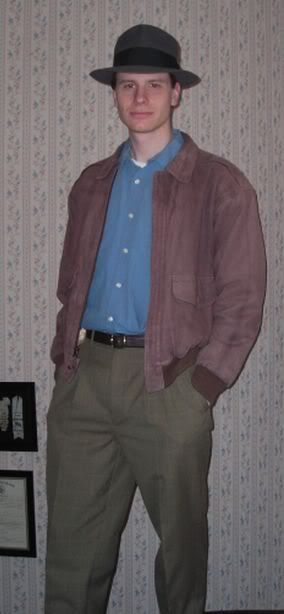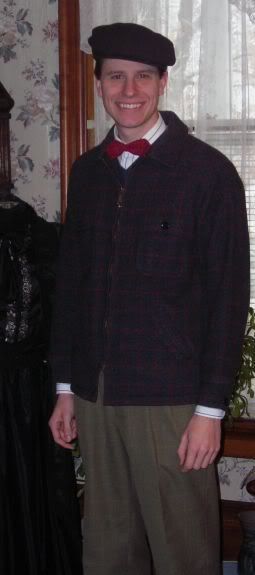Inspired by some of the flight jackets found over at the
Fedora Lounge, both vintage and modern, I took it upon myself last year to paint my very own World War Two-style flight jacket.
I bought the below A-2 style jacket at a garage sale for $3. It is not styled authenticly like a WW2 jacket but it does need to be perfectly authentic, especially since this is my first painted jacket. It fits well though is quite worn. The knit waistband is stretched. Yet these scars add a pinch of attitude and "combat wear" to the jacket.
I first started by deciding what I was going to paint on the jacket. I chose to paint the shield of the 56th Fighter Group on the left breast. Why the 56th? Because they were major users of the P-47 Thunderbolt, my favorite fighter of the Second World War. Anyways, the P-47 doesn't get enough credit.
I printed off the shield in the size I wanted, cut it out and traced the outlines in correct position on the jacket. Then, using acetone, I stripped the outlined area of any 'finish' the leather might have. I also lightly sanded the area with very fine sandpaper. This allows the paint to soak into the leather as well as give a rough texture to grab onto.
I then applied mulitple coats of watered down acrylic paint (I used craft paint that can be found at Wal-Mart). Thin coats allows the paint to soak into the leather so many coats must be applied to reach the desired vivid colors. Below is the nearly finished shield.

"Cave Tonitrum" is latin for "Fear the Thunderbolt", Thunderbolt being the nickname of the P-47.
After the shield was finished on the front I repeated the above technique on the back except with a different design. The finished product is below.
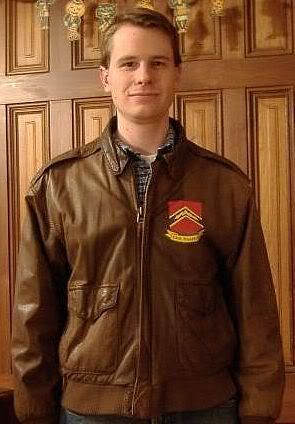

The plane is in the colors of the 56th FG. The "Highwayman" is yellow with a red outline on one side, giving the name a nice 3-D effect often seen on period flight jackets. I chose the name "Highwayman" as a tribute to the song by Johnny Cash, Willie Nelson, Waylon Jennings and Kris Kristofferson. The song can be found here.
After a bit of wear there is some paint flaking but this is normal and is easily fixed by reapplying paint to the flaked areas. A protective coat of clear sealer can be applied to give the artwork better protection and an extended lifespan.
Calling this type of project 'artwork' is not a misnomer. World War Two era painted jackets are quite collectable and go for large amounts not only because they are interesting to look at but also because they often can be identified to a specific unit and possibly a single pilot. Modern painted jackets are just as rare as vintage ones and are highly prized by their owners. The artwork adds a sense of personality to the jacket and lets the owner seemingly glance into the life of a long gone era when pilots wore painted jackets and flew prop-driven cadillacs of the sky.
 The above photo shows my favorite Art Deco skyscraper, though it's not the Empire State Building. It's the one in the background, the Chrysler Building.
The above photo shows my favorite Art Deco skyscraper, though it's not the Empire State Building. It's the one in the background, the Chrysler Building. And the highly polished gothic eagles scream of the 1930s.
And the highly polished gothic eagles scream of the 1930s. Of classic car hood ornaments. Of sleek 1930s racing planes. The spirit of the Golden Era.
Of classic car hood ornaments. Of sleek 1930s racing planes. The spirit of the Golden Era. It is a feast for the eyes.
It is a feast for the eyes.






 This plaque could help solve the mystery as to why the schools and city hall were all built in 1939. It seems there was some sort of economic initiative or project put into place in Boone in 1939 funded by the federal government. Interesting. To help recover from the Great Depression, no doubt.
This plaque could help solve the mystery as to why the schools and city hall were all built in 1939. It seems there was some sort of economic initiative or project put into place in Boone in 1939 funded by the federal government. Interesting. To help recover from the Great Depression, no doubt. The interior of city hall appears to be relatively unchanged.
The interior of city hall appears to be relatively unchanged.

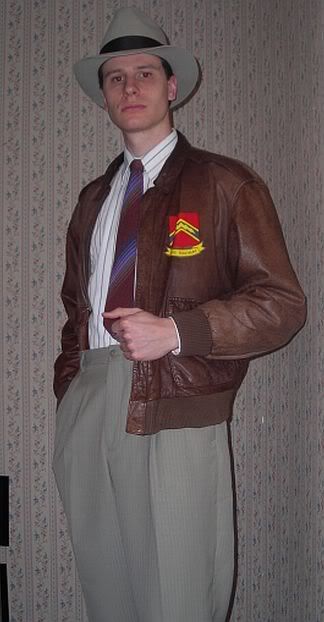
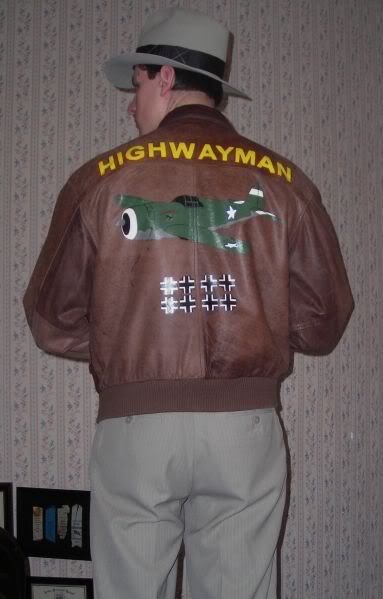
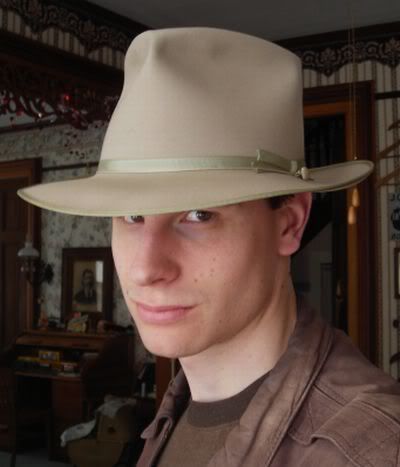

 "Cave Tonitrum" is latin for "Fear the Thunderbolt", Thunderbolt being the nickname of the P-47.
"Cave Tonitrum" is latin for "Fear the Thunderbolt", Thunderbolt being the nickname of the P-47.

